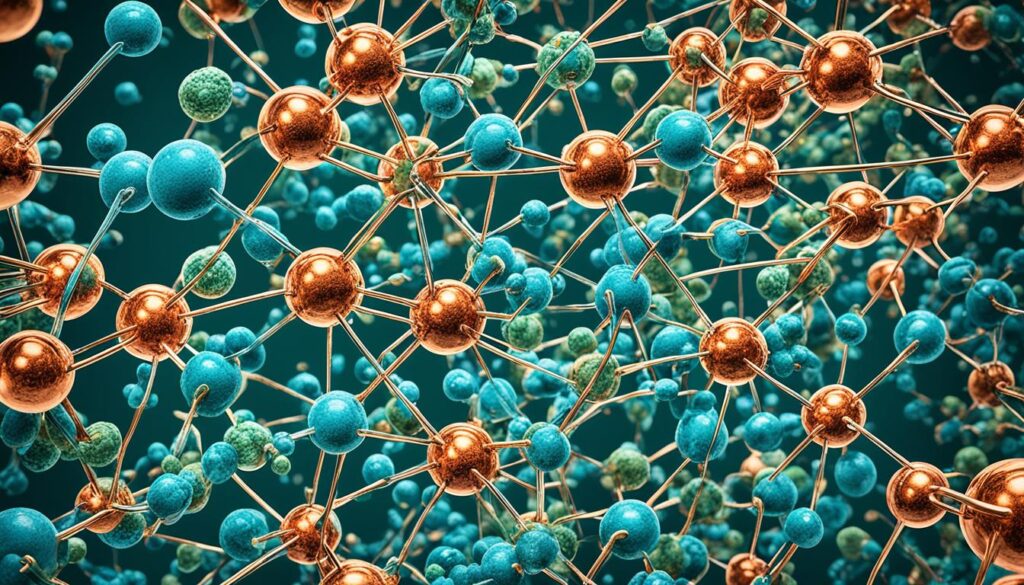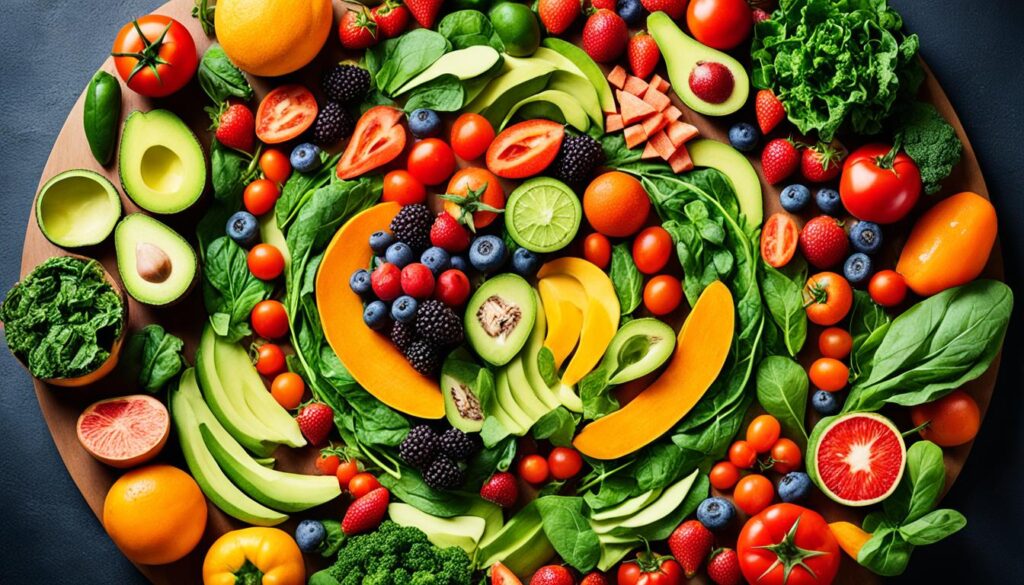Copper Nutrition Facts is an essential trace mineral that plays a vital role in various functions in the body, making it an important component of a healthy diet. From energy production to brain development and immune function, copper is involved in numerous physiological processes.
Understanding copper nutrition facts, including recommended intakes, deficiency, toxicity, and sources, can help you maintain optimal levels of this essential mineral. In this article, we delve into the key aspects of copper nutrition to provide you with the knowledge you need.
Key Takeaways:
- Copper is an essential trace mineral necessary for various bodily functions.
- The recommended dietary allowance (RDA) for copper is 900 micrograms per day for adults.
- Excessive copper intake can lead to toxicity, while deficiency is rare but can occur in individuals with genetic disorders or malabsorption problems.
- Food sources of copper include organ meats, shellfish, nuts, seeds, whole grains, and chocolate.
- Consulting with a healthcare provider is recommended for personalized dietary guidance and supplementation.
Recommended Amounts of Copper
In order to maintain optimal health, it is important to ensure an adequate intake of copper. The Recommended Dietary Allowance (RDA) for copper is 900 micrograms daily for adults. However, it is worth noting that slightly higher amounts are recommended for pregnant and lactating women to meet their increased needs.
Exceeding the recommended daily intake can lead to adverse effects. To prevent this, a Tolerable Upper Intake Level (UL) for copper has been established. For adults, the UL for copper is set at 10,000 micrograms daily.
These guidelines for copper intake, the RDA and UL, are essential for maintaining overall health and well-being. By following these recommendations, individuals can ensure that they are meeting their daily copper requirements without risking any potential negative effects from excessive intake.
| Age Group | RDA for Copper (μg/day) |
|---|---|
| Infants 0-6 months | 200 |
| Infants 7-12 months | 220 |
| Children 1-3 years | 340 |
| Children 4-8 years | 440 |
| Children 9-13 years | 700 |
| Males 14-18 years | 890 |
| Females 14-18 years | 890 |
| Males over 18 years | 900 |
| Females over 18 years | 900 |
| Pregnant females | 1,000 |
| Lactating females | 1,300 |
Roles of Copper in the Body
Copper is a vital mineral that plays diverse roles in maintaining optimal health and functioning of the human body. It performs essential functions that contribute to energy production, iron absorption, connective tissue formation, brain development, immune regulation, and protection against oxidative damage.
One of the primary functions of copper is its involvement in energy production. Copper is a crucial component of enzymes involved in cellular respiration, the process by which cells convert nutrients into energy. These enzymes, known as cytochrome c oxidases, facilitate the final step of the energy production process in mitochondria.

In addition to energy production, copper plays a vital role in the absorption and utilization of iron. It helps convert iron into a form that can be transported and used by the body. Copper deficiency can impair iron absorption, leading to decreased red blood cell production and the development of anemia.
| Copper Functions | Role in the Body |
|---|---|
| Energy production | Facilitates cellular respiration |
| Iron absorption | Converts iron for proper utilization |
| Connective tissue formation | Supports the structure and function of various tissues |
| Brain development | Essential for proper neurological function |
| Immune regulation | Supports immune system function |
| Antioxidant activity | Protects against oxidative damage |
Copper also contributes to the formation of connective tissue, which provides structural support to various organs and body systems. It plays a role in the synthesis of elastin, a protein that allows tissues to stretch and recoil, and collagen, a protein that forms the foundation for bones, tendons, and skin.
Furthermore, copper is essential for brain development and function. It is involved in the production of neurotransmitters, which facilitate communication between brain cells. Adequate copper levels are necessary for the normal functioning of the central nervous system, cognition, and memory.
Additionally, copper plays a crucial role in immune system regulation. It assists in the maturation and function of immune cells and helps in the defense against pathogens and foreign invaders.
Moreover, copper participates in the activity of antioxidant enzymes, such as superoxide dismutase, which neutralizes harmful free radicals and protects cells and tissues from oxidative damage. This oxidative damage is implicated in various chronic diseases and the aging process.
To summarize, copper is an indispensable mineral that performs vital functions in the body, ranging from energy production and iron absorption to connective tissue formation, brain development, immune regulation, and antioxidant activity.
Food Sources of Copper
Copper is an essential mineral that can be obtained from a variety of food sources. Incorporating these high-copper foods into your diet can help ensure an adequate intake of this important nutrient. Additionally, understanding how copper absorption is influenced by the copper content of the diet can further optimize your nutritional intake.
Some excellent sources of copper include:
- Organ meats, such as liver and kidney
- Shellfish, including oysters and mussels
- Fish, such as salmon and trout
- Nuts, including cashews and almonds
- Seeds, such as sesame seeds and pumpkin seeds
- Whole grains, like quinoa and oats
- Dark chocolate
These copper-rich foods not only provide a natural and flavorful way to enhance your copper intake but also offer additional essential nutrients that promote overall health.
When considering copper absorption, it is important to note that the copper content of the diet can influence how much copper is absorbed by the body. Consuming foods with lower copper levels can actually enhance copper absorption, while foods with higher copper levels may decrease absorption.
Incorporating a combination of high-copper foods and those with lower copper levels can help create an ideal balance for optimal copper absorption. This approach ensures that you are obtaining the necessary amount of copper while allowing your body to regulate absorption according to its needs.

To help visualize the copper content of various food sources, refer to the table below:
| Food Source | Copper Content (per 100g) |
|---|---|
| Organ Meat (beef liver) | 11.9mg |
| Shellfish (oysters) | 4.5mg |
| Fish (salmon) | 0.6mg |
| Nuts (cashews) | 2.2mg |
| Seeds (pumpkin seeds) | 1.8mg |
| Whole Grains (quinoa) | 1.5mg |
| Dark Chocolate (70-85% cocoa) | 3.3mg |
By incorporating a variety of copper-rich foods into your diet, you can ensure a sufficient copper intake while allowing your body to regulate copper absorption naturally. This balanced approach provides the right amount of copper for optimal health and well-being.
Signs of Copper Deficiency and Toxicity
Copper deficiency is a rare occurrence in healthy individuals. However, when it does happen, there may be certain symptoms to watch out for. Some common signs of copper deficiency include:
- Anemia
- High cholesterol levels
- Osteoporosis
- Increased susceptibility to infections
- Loss of skin pigmentation
Copper toxicity, although also rare, can lead to various health issues. Symptoms of copper toxicity may include:
- Liver damage
- Gastrointestinal symptoms, such as nausea and vomiting
- Headaches and dizziness
- Kidney problems
- Hemolytic anemia
It’s important to note that Wilson’s disease, a genetic condition, can cause copper to accumulate in the body, leading to copper toxicity.
Please consult with a healthcare professional for a proper diagnosis and personalized advice if you suspect copper deficiency or toxicity.

Importance of Copper in Cardiovascular and Brain Health
Copper plays a critical role in maintaining cardiovascular and brain health. Research has shown a correlation between copper levels and the risk of cardiovascular disease.
Higher levels of copper have been associated with a reduced risk of cardiovascular disease, including heart attacks and strokes.
Furthermore, ongoing studies are exploring the link between copper and Alzheimer’s disease. Some research suggests that both copper deficiency and excess may contribute to the development and progression of Alzheimer’s disease.
In particular, copper is involved in the formation of amyloid plaques, a hallmark of Alzheimer’s disease. However, more research is needed to fully understand the complex relationship between copper and this neurodegenerative disorder.
Additionally, copper has been implicated in the development and progression of certain types of cancer. Some studies have found that copper can promote tumor growth, angiogenesis, and metastasis.
However, it is important to note that the role of copper in cancer is still being investigated and further research is needed to elucidate the exact mechanisms involved.

Overall, copper plays a crucial role in maintaining cardiovascular and brain health. Further research will help us better understand the intricate relationship between copper and these diseases, potentially leading to new therapeutic approaches.
Copper and Food Safety
Excessive levels of copper in drinking water can present a potential health risk. This can occur when old pipes and faucets corrode over time, causing copper to leach into the water supply. Stagnant water and hot tap water can further increase copper levels.
To minimize exposure to excess copper, it is advisable to use cold tap water for drinking and cooking purposes. Avoid using hot tap water, as heat can expedite the release of copper into the water. By opting for cold tap water, you can reduce the potential for copper toxicity.
Another potential source of copper exposure is through the use of copper cookware. While copper cookware offers excellent heat conductivity and aesthetic appeal, it can contribute to copper toxicity if not used correctly. Acidic foods, such as tomatoes and citrus fruits, can cause copper to leach into the food. Therefore, it is recommended to line copper cookware with a non-reactive layer, such as stainless steel, and to avoid cooking highly acidic foods in direct contact with copper surfaces.
Furthermore, it is essential to be cautious when consuming food stored or served in corroded copper or brass vessels. Corrosion can lead to the release of copper into the food, increasing the risk of copper toxicity. If you suspect that a copper vessel is corroded, it is best to refrain from using it for food storage or preparation.

Copper Supplementation
Copper supplementation can be beneficial for individuals who need to increase their copper intake. However, it is crucial to consult with a healthcare provider before starting any supplementation. Taking copper supplements should be done under medical supervision to ensure proper dosing and to avoid potential interactions with other medications or health conditions.
“Proper consultation with a healthcare provider is essential before initiating copper supplementation to determine the appropriate dosage and address any potential risks or contraindications.”
It is important to remember that copper supplementation should not be undertaken without medical advice. A healthcare professional can help assess your individual copper needs and determine if supplementation is necessary based on your medical history, diet, and current copper levels.
Copper supplements are available in various forms, including capsules, tablets, and liquid solutions. The dosage will depend on the specific needs of the individual. It is important to follow the recommended dosage provided by the healthcare provider and not exceed the safe upper limits of copper intake.
Potential Interactions and Side Effects
Due to potential interactions with other medications and health conditions, it is essential to inform your healthcare provider about any other medications, supplements, or health issues you have. Certain medications, such as zinc supplements or high-dose vitamin C, may interfere with copper absorption. It is important to discuss these potential interactions with your healthcare provider to ensure optimal results and avoid any adverse effects.
While copper supplementation can be beneficial for those with copper deficiency or specific medical conditions, it is not recommended for everyone. Excessive copper intake can be harmful and lead to copper toxicity. Symptoms of copper toxicity may include gastrointestinal distress, liver damage, and neurological symptoms.
Copper Supplementation Guidelines
Here are some general guidelines to follow when considering copper supplementation:
- Consult with a healthcare professional: Before starting any copper supplement, consult with a healthcare provider to determine if it is necessary and the appropriate dosage.
- Stick to recommended dosage: Follow the recommended dosage provided by your healthcare provider and avoid exceeding the safe upper limits of copper intake.
- Be aware of potential interactions: Inform your healthcare provider about any other medications, supplements, or health conditions you have to avoid potential interactions.
- Monitor for side effects: Pay attention to any adverse reactions or side effects while taking copper supplements and promptly communicate them to your healthcare provider.
- Regularly review copper levels: Periodically monitor your copper levels through blood tests to ensure proper copper supplementation and avoid copper toxicity.
Remember, the best approach is to consult with a healthcare provider who can provide personalized guidance based on your specific needs and medical history.
Balancing Copper Intake with Other Nutrients
When it comes to maintaining optimal health, it’s important to consider the balance of copper intake with other essential nutrients. Copper interacts with two particular nutrients: zinc and iron. Understanding how these interactions can impact copper levels is crucial for overall well-being.
Zinc and Copper Balance
Zinc and copper have a delicate symbiotic relationship in the body. While both minerals are essential, high doses of zinc supplements can interfere with copper absorption, potentially leading to a copper deficiency. It’s vital to strike the right balance between zinc and copper to ensure adequate levels of both minerals.
Iron and Copper Interaction
Iron and copper also interact in the body. Excessive iron intake can hinder copper absorption, potentially disrupting the copper balance. Maintaining an appropriate iron and copper ratio is essential for optimal health and the proper functioning of various bodily processes.
By maintaining a balanced intake of these nutrients, you can support your overall health and well-being. It is always recommended to consult with a healthcare professional or registered dietitian to determine the appropriate intake of copper, zinc, and iron based on individual nutritional needs.
| Nutrient | Recommended Daily Intake | Sources |
|---|---|---|
| Copper | 900 micrograms for adults | Organ meats, shellfish, fish, nuts, seeds, whole grains, chocolate |
| Zinc | 11 milligrams for men, 8 milligrams for women | Oysters, beef, poultry, beans, nuts, whole grains |
| Iron | 8 milligrams for men, 18 milligrams for women | Red meat, poultry, fish, legumes, leafy greens |
Copper in the Environment and Copper Toxicity
Copper can be found in various environmental sources, including water, soil, and air. Environmental exposure to copper can occur through different means, such as water contamination, agricultural practices, and industrial processes.
Water contamination is one of the primary ways in which individuals can be exposed to copper. Old, corroded pipes and faucets can release copper into drinking water, especially when the water has been stagnant or when hot tap water is used. These factors can significantly increase copper levels in the water and potentially contribute to copper toxicity.
Agricultural practices also play a role in copper environmental exposure. Copper-based pesticides and fungicides are commonly used in farming to protect crops from diseases and pests. However, these agricultural activities can lead to the accumulation of copper in the soil, which may then be absorbed by plants and enter the food chain.
Industrial processes, such as mining and manufacturing, generate copper-containing waste materials that can contaminate the surrounding environment. These pollutants can seep into the soil, water sources, and air, further increasing the exposure to copper.
Although copper toxicity is relatively rare, prolonged exposure to high levels of copper can lead to adverse health effects. Copper toxicity can manifest in various symptoms, including gastrointestinal disturbances, liver damage, kidney dysfunction, and neurological disorders.
To minimize exposure to excessive copper, proper safety measures should be taken. This includes regularly testing water for copper levels, using cold tap water for drinking and cooking, and avoiding the use of hot tap water. Additionally, it is essential to be cautious of copper-based pesticides and fungicides in agriculture and to follow recommended safety guidelines in industrial settings to prevent copper environmental exposure.
Stay informed and take proactive steps to ensure your safety and well-being in relation to copper exposure in the environment.
Also Read:- 7 Foods To Avoid For Better Skin
Copper Environmental Exposure: Sources and Risks
| Environmental Source | Main Contributors | Risks |
|---|---|---|
| Water | Corroded pipes, stagnant water, hot tap water | Ingestion of copper-contaminated water leading to copper toxicity |
| Soil | Agricultural practices, mining, manufacturing | Copper accumulation in soil and its subsequent absorption by plants, potentially entering the food chain |
| Air | Industrial emissions, combustion processes | Inhalation of copper particles, contributing to copper exposure |
Conclusion
Copper is an essential trace mineral that plays a crucial role in various body functions. From energy production to brain development, copper is indispensable for maintaining optimal health. Adequate copper intake is essential for overall well-being and can be obtained through a diverse range of food sources.
By including copper-rich foods like organ meats, shellfish, nuts, seeds, and whole grains in your diet, you can ensure a sufficient supply of this vital mineral. However, in certain cases, supplementation may be necessary, especially for individuals with copper deficiency or specific health conditions. It is always recommended to consult with a healthcare provider for personalized dietary guidance and supplementation.
While copper is necessary for our health, it is important to be mindful of both deficiency and toxicity. Being aware of the symptoms associated with copper deficiency, such as anemia and increased infections, can help you maintain optimal copper levels. Similarly, understanding the signs of copper toxicity, including liver damage and gastrointestinal symptoms, is crucial for avoiding adverse effects.
Balance is key when it comes to copper intake. Copper interacts with other important nutrients like zinc and iron, so maintaining a proper balance is essential. High doses of zinc supplements can interfere with copper absorption, while excessive iron intake may hinder copper absorption. Ensuring a balanced intake of these nutrients will support your overall health and well-being.
FAQs
Q: What are the health benefits of copper and why is it considered essential for a healthful diet?
A: Copper is a vital mineral that plays a key role in various bodily functions, including energy production, red blood cell formation, and maintenance of healthy bones and connective tissues.
Q: Is it possible to get enough copper through diet alone?
A: While it is possible to get enough copper through a balanced diet that includes copper-rich foods such as nuts, seeds, whole grains, and seafood, some individuals may benefit from copper supplements.
Q: What are the potential effects of copper deficiency?
A: Copper deficiency can lead to anemia, bone abnormalities, impaired immune function, and neurological issues. It is important to consult a health care provider if you suspect you have low copper levels.
Q: Are there risks associated with consuming too much copper?
A: Consuming high amounts of copper through supplementation or excessive intake of copper-rich foods can lead to copper toxicity, which may cause symptoms such as nausea, vomiting, and abdominal pain.
Q: Can wearing copper bracelets help increase copper levels in the body?
A: While some believe that wearing copper bracelets can help boost copper levels in the body, there is limited scientific evidence to support this claim. It is always best to focus on consuming copper through diet or supplements.
Q: What are some foods high in copper that can be included in the diet?
A: Foods such as shellfish, nuts, seeds, legumes, whole grains, dark leafy greens, and chocolate are rich sources of copper and can help individuals meet their daily copper requirements.
Q: How can copper supplements be beneficial for individuals who struggle to get enough copper from their diet?
A: Copper supplements can be beneficial for individuals with specific dietary restrictions or conditions that affect copper absorption, ensuring they are meeting their daily copper needs for optimal health.





